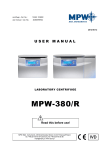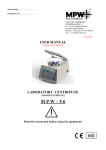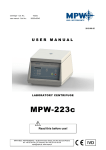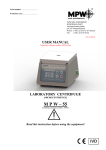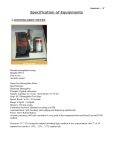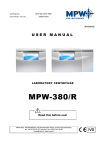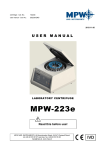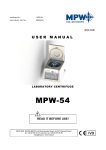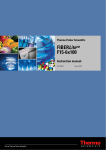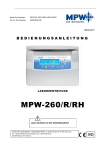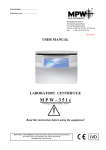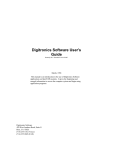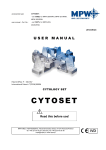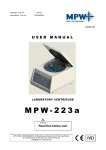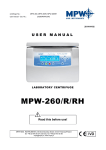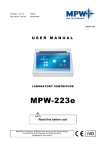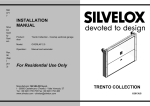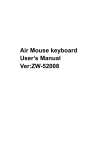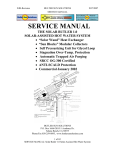Download MPW-260/R/RH - MPW MED. INSTRUMENTS Spółdzielnia Pracy
Transcript
1 centrifuge - Cat. No.: 10260, 10260R, 10260RH user manual - Cat. No.: 20260/R/RH/ENG 2012-11-09 USER MANUAL LABORATORY CENTRIFUGE MPW-260/R/RH Read this before use! MPW Med. instruments, 46 Boremlowska Street, 04-347 Warsaw/Poland tel. +48 22 610 81 07 (service), fax +48 22 610 55 36 [email protected], www.mpw.pl Warning sings and hazard icons. WARNING Warning of potential injury or health risk. DANGER Risk of electric shock with potential for severe injury or death as a consequence. DANGER Biohazard with potential for risk to health or death as a consequence. DANGER Risk of explosion with potential for severe injury or death as a consequence. Statement of Conformity: The following machine is in accordance with the regulations of the EU Directive 98/79/EC and with the harmonized standards PN-EN 61010-1 and PN-EN 61010-2-020. 2 CONTENTS 1. APPLICATION. 5 2. TECHNICAL SPECIFICATION. 5 2.1.1. BASIC ACCESSORIES (DELIVERED WITH EVERY CENTRIFUGE). 2.1.2. OPTIONAL ITEMS. 6 6 2.2. EXPLOITATION ITEMS. 9 3. INSTALLATION. 10 3.1. UNPACKING OF THE CENTRIFUGE. 3.2. LOCATION. 3.3. CONNECTION TO MAINS. 3.4. FUSES. 10 10 10 10 4. CENTRIFUGE OVERVIEW. 11 4.1. OVERVIEW. 4.2. CONTROL AND DISPLAY ELEMENTS. 11 11 5. SAFETY CONDITIONS. 12 5.1. SERVICING PERSONNEL. 5.2. GUARANTEE AND OPERATIONAL USE PERIOD. 5.3. SAFEKEEPING PERIOD. 5.4. HINTS ON CENTRIFUGING. 5.5. HAZARDS AND PRECAUTIONS 12 12 12 12 13 6. OPERATION. 14 6.1. MOUNTING OF THE ROTOR AND ACCESSORIES. 6.3. DRIVE. 6.4. DATA INPUT AND OUTPUT. 6.5. CONTROLS. 6.6. SAFETY DEVICES. 14 15 15 15 16 6.6.1. COVER LOCK. 6.6.2. UNBALANCED LOAD CHECKING SYSTEM. 6.6.3. ROTOR INSTALLATION AND SOFTWARE COMPATIBILITY VERIFICATION UNIT. 6.6.4. COVER OPENING. 6.6.5. CHECKING OF EXCESSIVE TEMPERATURE. 16 16 16 16 16 7. OPERATING CONTROLS AND FUNCTION. 17 7.1. CONTROL PANEL 7.2. SWITCHING THE CENTRIFUGE ON. 17 21 7.2.1. SELECTION OF THE PROGRAM. 7.2.2. START OF THE PROGRAM. 7.2.3. ROTOR INSTALLATION AND SOFTWARE COMPATIBILITY VERIFICATION UNIT. 7.2.4. ERROR UNBALANCE FAULT. 7.2.5. EMERGENCY STOP. 21 21 21 22 22 3 7.2.6. END OF THE CENTRIFUGING. 7.2.7. PARAMETERS MONITORING DURING CENTRIFUGING. 7.2.8. PROGRAMMING. 7.2.9. CANCELLATION OF THE PROGRAMS. 7.2.10. VERSION OF THE CENTRIFUGE. 22 22 23 24 24 7.3. MATHEMATICAL RELATIONS. 25 7.3.1. RCF – RELATIVE CENTRIPETAL FORCE. 7.3.2. NOMOGRAPH OF RELATIONSHIP - ROTATIONAL SPEED/CENTRIFUGING RADIUS/RCF – DRAWING NO. 5. 7.3.3. MAXIMUM LOAD. 25 25 25 7.4. TEMPERATURE IN ROTATIONAL CHAMBER MPW-260R/RH . 25 8. CLEANING, DISINFECTION, MAINTENANCE. 26 8.1. CLEANING OF THE CENTRIFUGE. 8.2. CLEANING ACCESSORIES. 8.3. LUBRICATION. 8.4. GLASS TUBE CRACKING. 8.5. STERILIZATION AND DISINFECTIONS OF ROTATIONAL CHAMBER AND ACCESSORIES. 26 26 26 26 27 9. TROUBLESHOOTING 28 9.1. GENERAL ERRORS. 9.2. WORK SAFETY INSPECTION. 9.3. INSPECTION PROCEDURES CARRIED OUT BY THE OPERATOR. 28 29 29 10. GUARANTEE CONDITIONS. 30 11. DISPOSAL. 30 12. MANUFACTURER’S INFORMATION. 30 13. DISTRIBUTOR INFORMATION. 30 14. APPENDIX 31 14.1. NOMOGRAPH. 31 14.2. TABLE OF CHEMICAL RESISTANCE TO THE INTERACTION OF VARIOUS CATEGORIES OF REAGENTS OF PLASTICS 32 14.3. PRINTING CENTRIFUGING – USB, RS232, PRINTER 33 Annexes: Statement of conformity Declaration of decontamination (repair) Declaration of decontamination (return) 4 1. Application. The MPW-260/R/RH centrifuges are table top laboratory centrifuge for in vitro diagnostic (IVD). Devices are used for separation samples taken from people's, animal’s and plant’s components of different densities, under the influence of the centrifugal force, to provide information about their biological state (MPW-260 – ventilated, MPW-260R – with cooling, MPW-260R – with cooling and heating). Its construction ensures easy operation, safe work and wide range of applications at laboratories engaged in routine medical analyses, biochemical research works etc. This centrifuge is not biotight and therefore during centrifugation of preparations requiring biotightness one has to use closed and sealed containers and rotors. In the centrifuge, it is prohibited to centrifuge caustic, inflammable and explosive preparations. 2. Technical Specification. manufacturer type cat no. mains voltage, L1+N+PE, 10% mains frequency, 10% connected load current protection cooling medium capacity (max.) speed – RPM force – RCF kinetic energy (max.) running time time counting short-time operation mode (SHORT) continuous operation mode (HOLD - ∞) user programms adjustable temperature initial cooling (PRECOOLING) cooling without centrifuging cooling after centrifuging (COOL AFTER) acceleration curves deceleration curves adjustable curves: MPW Med. instruments 46 Boremlowska Street, 04-347 Warsaw, Poland MPW – 260 MPW - 260R MPW – 260RH 10260 10260R 10260RH 230V 115V 230V 115V 230V 50Hz 60Hz 50Hz 200W 4A --- 60Hz 50Hz 60Hz 50Hz 60Hz 60Hz 450W 10A 6,3A R507 (CFC, HCFC free) 500 ml 100 18000 (res. 100) 24088 x g 8800 Nm 0 s 99 min 59 s (res. 1s), since start button is pressed, since preselected speed is reached yes (up to 15 min.) yes 99 -20 ÷ 55ºC to 40C -20 ÷ 40C no 2500 RPM, 4C / 0 RPM 4C no yes 6,3A no yes 10 (linear) 10 (9 linear, 1 rundown) acceleration 10 deceleration 10 USB interface EMC ambient conditions set-up site ambient temperature humidity (maximum relative humidity) excess-voltage category pollution degree safety area dimensions height width depth noise level weight 50Hz yes PN-EN 55011 (PN-EN 61010-1 pkt.1.4.1) indoors only 5º ÷ 40ºC < 80% II (PN-EN 61010-1) 2 (PN-EN 61010-1) 300 mm 320 mm 365 mm 495 mm 320 mm 365 mm 660 mm 56 dB ~ 28 kg 5 ~ 46,5 kg 2.1. Accessories. 2.1.1. Basic accessories (delivered with every centrifuge). Cat. No. 17142 17099T 17642 17861 17862 17863 17866 17866 20260/R/RH/ENG Type of accessories Complete clamp Spanner for the rotor Spanner for emergency opening of the cover Fuses WTA-T 4 A 250 V Fuses WTA-T 6,3 A 250 V Fuses WTA-T 10 A 250 V Power cord 230 V Power cord 115 V Operating Instruction pcs 1 1 1 2 or 2 or 2 2 or 1 1 2.1.2. Optional items. Depending on customer’s needs MPW-260/R/RH centrifuge can be delivered with following accessories: ANGLE ROTORS Cat. No Type of rotor 11199 11213 11216 11217 11461 11462 11715 11716 11717 11718 11740 11741 11742 11743 11744 11745 11746 Angle rotor HSL Angle rotor Angle rotor Angle rotor Angle rotor HSL Angle rotor HSL Angle rotor HSL Angle rotor HSL Angle rotor HSL Angle rotor Angle rotor Angle rotor Angle rotor Angle rotor Angle rotor Angle rotor Angle rotor Angle 45o 30o 30o 30o 45o 45o 30o 45o 45o 30o 30o 30o 45o 30o 30o 30o 30o Rotor capacity Max rpm RCF 12 x 2,0/1,5 ml 8 x 50 ml 12x5 ml 10x15 ml 24 x 2,0/1,5 ml 36 x 2,0/1,5 ml 10 x 10 ml 4 x 8 x 0,2 ml PRC 18 x 2,0/1,5 ml/filter 4 x 100 ml 12 x 15 ml 8 x 15 ml 4 x 30/25 ml 12 x 30/25 ml 10 x 50 ml 24 x 15/10 ml 6 x 50 ml 18000 5000 14000 6000 14000 14000 14000 14000 14000 5000 5500 6000 6000 4500 4500 5000 6000 24088 3494 19064 4226 18187 18187 15558 15339 18187 3158 4058 4226 4829 2716 2830 3354 4427 rmax rmin [cm] [cm] 6,65 3,5 12,5 7,9 8,7 3,5 10,5 4,0 8,3 5,0 8,3 4,0 7,1 3,0 7,0 6,2 8,3 5,0 11,3 5,0 12 4,6 10,5 4,0 12 5,5 12 5,0 12,5 4,3 12 4,6 11 4,9 HS – hermetically sealed HS accessories maintenance. Make sure that rubber O-rings are lightly coated with silicone grease. Use high vacuum grease, e.g. type „C” by LUBRINA. 6 SWING-OUT ROTORS Cat. No Type of rotor 12172 Swing-out drum rotor 6 adapters 20 x 0,4/0,2 ml or 10 x 2,0/1,5ml Swing-out rotor 4 x 100 ml Swing-out rotor 8 x 15/10 ml Swing-out rotor 2 microtiter plates (MTP) Swing-out rotor 4 x 7 x 10/5 ml Hematocrit rotor 24 capillary tubes 75mm 12183 12193 12218 12232 12300 Rotor capacity Max rmax rmin RCF rpm [cm] [cm] 14000 15338 7,0 3,0 4000 2469 13,8 4000 2504 14,0 3000 916 9,1 4000 2308 12,9 13000 16816 8,9 4,2 5,4 7,7 6,3 1,4 BUCKETS Catalog no Application 13080 13081 13170 13182 13184c 13195 13219 13233 Bucket 17,7x87 mm for 15/10/7/6 ml test tubes for rotor 11217, 11740, 11741, 11745; Bucket 17,7x65 for 10/6/5 ml test tubes for rotor 11217, 11740, 11741, 11745; Bucket 13x81 mm for 12x5 ml test tubes for rotor 12232; Bucket 45x89 for 100 ml test tubes and round carriers 14186÷14192, 14196 for rotor 12183; Bucket 45x96 for 100 ml test tubes and round carriers 14186÷14192, 14196 for rotor 12183; Hanger for 2 buckets 13080 for 15 ml Falcon test tubes for rotor 12183; Bucket 85x130 mm for 1 microtiter plate for rotor 12218; Bucket 57,2x66 70 ml for rotor 12232 for round carriers 14169, 14235, 14238, 14239, 14240, 14242; Bucket 30x100 mm for 50 ml Falcon test tubes for rotor 12183; Bucket 30x100 mm for 50 ml Falcon test tubes with thread or cap for rotor 12183 Bucket 30x99 mm for 50/30/25 ml Falcon test tubes with thread or cap for rotor 11213; Bucket 30x96 mm for 50/30/25 ml Falcon test tubes for rotor 11213, 11744, 11746; Bucket 25,5x86 mm for 30/25 ml test tubes for rotor 11742, 11743; Round bucket 45x96 mm for 100 ml test tubes for rotor 11718; 13266 13267 13275 13276 13329 13719 ROUND CARRIERS Catalog no 14000 14002 14024 14082 14084 14089 14126 14133 14169 14181 14186 14187 14188 14189 14190 14192 14196 14235 Application Adapter 20x0,4 ml for rotor 12172; Adapter 10x2,0/1,5 ml for rotor 12172; Round carrier 44,5 for 15 ml Falcon test tubes ( 17x120 mm) for bucket 13182 and 13084; Round carrier 17,3 for 7/5 ml test tubes ( 13,3x100 mm) for bucket 13080 and 13081; Round carrier 11,0 for 0,5 ml test tubes ( 8,0x30 mm) for rotor 11199, 11461, 11462; Round carrier 29 for 15 ml Falcon test tubes ( 17x120 mm) for bucket 13266, 13267, 13276; Round carrier 11 for 0,4 ml test tubes (5,8x46 mm) for rotor 11259, 11461, 11462, 11739; Round carrier 10,8 for 0,2 ml test tubes (6,2x21 mm) for rotor 11259, 11461, 11462, 11739; Round carrier 56,5 for 8x4ml test tubes ( 13,5x81mm) for bucket 13233; Round carrier 44,5 for 5x2/7 ml test tubes ( 12,5x58 mm) for bucket 13182, 13184; Round carrier 44,5 for 4x7 ml test tubes (13,1x100 mm) for bucket 13182, 13184; Round carrier 44,5 for 4x10 ml test tubes (16,1x100 mm) for bucket 13182, 13184; Pad under 100/50/30/25 ml test tubes for bucket 13182, 13184, 13719; Round carrier 44,5 for 50 ml Falcon test tubes ( 30x120 mm) for bucket 13182, 13184, 13719; Round carrier 44,5 for 30/25 ml test tubes (25,5x100 mm) for bucket 13182, 13184, 13719; Round carrier 44,5 for 50 ml test tubes (35x100 mm) for bucket 13182, 13184, 13719; Round carrier under 100 ml test tubes for bucket 13182, 13184, 13719; Round carrier 56,5 for 12x50 ml test tubes (12x75 mm) for bucket 13233; 7 14238 14239 14240 14242 14248 14255 14256 Round carrier 56,5 (short) for 7x10 ml test tubes (16,7x75 mm) for bucket 13233; Round carrier 56,5 (short) for 7x5 ml test tubes (13,5x75 mm) for bucket 13233; Round carrier 56,5 for 9x2,0/1,5 ml test tubes (11x38,5 mm) for bucket 13233; Round carrier 56,5 for 12x1,2 ml S-Monovette test tubes (9/13 x 66 mm) for bucket 13233; Round carrier 29,8 for 30/25 ml test tubes (26x100 mm) for bucket 13266, 13267, 13275 and 13276; Round carrier 25 for 7 ml test tubes ( 13x100 mm) for bucket 13329; Round carrier 25 for 15/10 ml test tubes ( 17x120 mm) for bucket 13329; TEST TUBES Catalog no. Specification 15015 15016 15040 15046 15048 15050 15052 15053 15054 15055 15067 15098 15100 15102 15115 15116 15117 15118 15119 15120 15121 15122 15124 15125 15127 15128 15130 15131 15419 Polypropylene test tube 2 ml with cap ( 10,8x41,2 mm); Polypropylene test tube 1,2 ml S-Monovette with cap ( 8,8/13,4x82,3mm) Polypropylene test tube 100 ml with cap ( 44,5x103 mm); Polypropylene test tube 14 ml with cap ( 16,8x113 mm); Polypropylene test tube 15 ml Nalgene ( 16x113 mm); Polypropylene test tube 15 ml Falcon ( 17/21x120 mm); Polypropylene test tube 50 ml Falcon ( 30/35x120 mm); Polypropylene test tube 10 ml with cap ( 16/19x100 mm); Polypropylene test tube 6 ml with cap ( 11,5x92 mm); Polypropylene test tube 30 ml with cap ( 24,8x100 mm); Polycarbonate test tube 85 ml Nalgene with cap ( 37,8x106 mm); Capillary tube stoppers; Microhematocrite capillary tubes, heparinized (1,4x75mm); Micro titer plate with cap (85,5x127 mm); Glass tube 100 ml ( 45x100 mm); Glass tube 50 ml ( 35x100 mm); Glass tube 25 ml ( 25x100 mm); Glass tube 10 ml ( 16x100 mm); Glass tube 7 ml ( 12x100 mm); Glass tube 5 ml ( 12x75 mm); Polypropylene test tube 10 ml with stopper ( 17x70 mm); Polypropylene PCR test tube 8x0,2 ml ( 6x21 mm) with integrated caps; Polypropylene test tube 0,4 ml ( 5,7x46 mm); Polypropylene test tube 0,2 ml PCR ( 6x21 mm); Polypropylene test tube 0,5 ml with cap ( 7,8x30 mm); Polypropylene test tube 1,5 ml with cap ( 10,8x39 mm); Polypropylene PCR test tube 8x0,2 ml ( 6x21 mm); Polypropylene PCR test tube 4x0,2 ml ( 6x21 mm); Polypropylene test tube 5 ml ( 12x75 mm); 8 OTHER ACCESSORIES Catalog no 16135 16164 16594 16595 17151 17185 Specification Hematocrite reader – flat Hematocrite reader – round Data recording set of working parameters by USB port; Thermal printer of working parameters by serial RS 232; Polycarbonate cap for bucket No. 13267, 13275; Aluminium cap for bucket No. 13184; CAUTION! Optional accessories marked by: “” are delivered for individual order. 2.2. Exploitation items. For operating in centrifuge one should use only original company’s buckets comprised in the specification of accessories as well as test-tubes for centrifuges of proper diameter, length and strength. Utilization of test-tubes of other makes shall be agreed upon with manufacturer of the centrifuge. For cleaning and disinfecting one should use agents generally applied in the health service, such as e.g. Aerodesina-2000, Lysoformin 3000, Melseptol, Melsept SF, Sanepidex, Cutasept F. 9 3. Installation. 3.1. Unpacking of the centrifuge. Open the package. Take out the cardboard box containing the accessories. Take out the centrifuge from the package. Keep the package and packing materials at hand for service transport. 3.2. Location. The centrifuge shall not be located near source of heat and shall not be subjected to direct sunlight. The table for the centrifuge shall be stable and shall have flat-levelled table top. It is necessary to ensure a safety zone of the minimum 30 cm round the centrifuge from every direction. Normal operating conditions ambient temperature is from 15 C to 35 C. Passed parameters of the centrifuge are referring to the above named temperatures. At the change of the place from cold to warm one, condensation of water will occur inside the centrifuge. It is important then that sufficient time be provided for drying the centrifuge prior to starting the centrifuge again (minimum 4 hours). 3.3. Connection to mains. Supply voltage given on the rating plate has to be consistent with local supply voltage. MPW Med. instruments laboratory centrifuges are 1st safety class devices and they are provided with the threecore cable with the plug resistant to dynamic loadings. Mains socket shall be provided with the safety pin. It is recommended to install emergency cut-out that shall be located far from the centrifuge, near the exit or beyond the room. . Before switching on, check whether the centrifuge is connected to power supply correctly. Check centrifuge before usage whether she is installed correctly. 3.4. Fuses. The centrifuge is equipped with thermal current protection. Fuse is situated in the plug-in socket unit at back wall of the centrifuge. 10 4. Centrifuge overview. 4.1. Overview. New generation of MPW Med. instruments laboratory centrifuges is provided with state-of-the-art microprocessor control systems, very durable and quiet asynchronous brushless motors and accessories consistent with requirements of the present-day user. 4.2. Control and display elements. 4 1. Power switch 2. Control panel 3 3. Cover 4. Inspection glass 5 2 5. Emergency cover open place 1 Drawing No.1. General view Drawing No.2.Back of centrifuge 1. Plug-in socket 2. Fuse base 3. RS 232 socket 1 4 1. Motor axle 3 2. Rotor 3. Rotor cover 4. Complete clamp 2 1 Drawing No. 3. Unit elements of the angle rotor 11 2 3 5. Safety conditions. 5.1. Servicing personnel. The MPW-260/R/RH laboratory centrifuge can be operated by laboratory personnel after getting acquainted with Operating Instruction. Operating Instruction shall be held all the time near the centrifuge. Operating Instruction must be kept always at hand!!! 5.2. Guarantee and operational use period. Guarantee period for the MPW-260/R/RH centrifuge amounts to minimum 24 months. Principles are specified in guarantee certificate. The service life of the centrifuge specified by the manufacturer amounts to 10 years. After termination of guarantee period it is necessary to carry out yearly technical inspections of the centrifuge. Only service personnel authorized by manufacturer may perform the inspections. The manufacturer reserves the right to make modifications to produced goods. 5.3. Safekeeping period. Maximum period of storage of not used centrifuge amounts to 1 year. After this period, a service authorized by manufacturer should carry out technical inspection of the centrifuge. 5.4. Hints on centrifuging. Set the centrifuge in horizontal position on rigid base. Ensure safe positioning location. Ensure free space around the centrifuge (amounting to at least 30 cm left free). Ensure sufficient ventilation. Fix the rotor on the motor axis firmly. Avoid unbalance. Load opposite buckets with the same accessories. Centrifugation of the test tubes of different sizes. There is a possibility to centrifuge test tubes of different sizes; however, it is absolutely necessary in such cases that opposite buckets and round carriers be the same. Mass of different containers with test tubes spun at the same time has to be comparable. Not only the test tubes shall be inserted symmetrically, but also round carriers and their hangers shall be equally loaded. It is e.g. not allowed to operate centrifuge only external part of reductive insert loaded. 12 It is necessary to insert test tubes symmetrically on the opposite sides. Fill test tubes outside the centrifuge. Please pay special attention to the quality and proper thickness of the glass test tubes walls. Those shall be test tubes for centrifuges, of proper durability up to 5,000 x g. In order to protect the centrifuge against unbalance, fill in the test tubes up to the same weight. Lubricate the swing-out rotor journal pins. Use only accessories in good condition. Protect equipment against corrosion using accurate preventive maintenance. Infectious materials could be processed in closed buckets only. It is not allowed to centrifuge explosive and inflammable materials. It is not allowed to centrifuge substances prone to reacting in result of supplying high energy during centrifugation. 5.5. Hazards and precautions Prior to switching the centrifuge on, one shall read carefully all sections of this instruction in order to ensure smooth operation and avoid damages of this device or its accessories. Centrifuge shall not be operated by unqualified personnel. Centrifuge must not be transported with the rotor mounted on the shaft. One must use original rotors, test-tubes and spare parts only. In the case of faulty operation of the centrifuge one shall ask for assistance of service of MPW Med. instruments Company or its authorized representatives. It is not allowed to switch the centrifuge on if it is not installed properly or rotor is not fitted correctly. The centrifuge must not be operated in places where explosion hazard exists as it is not explosion-proof. It is not allowed to centrifuge materials capable of generating inflammable or explosive mixtures when subjected to air. It is not allowed to subject to centrifugation toxic or infectious materials with damaged leak proof seals of the rotor or test-tube. Proper disinfection procedures have to be carried out when dangerous substances contaminated the centrifuge or its accessories. 13 It isn't allowed to open the cover manually in emergency procedure when rotor is still turning. It isn't allowed to exceed load limit set by the manufacturer. Rotors are intended for fluids of average homogeneous density equal to 1.2 g/cm3 or smaller when centrifugation is carried out at maximum speed. When fluids of higher density shall be used, then it is necessary to limit speed (see point 7.3.3 “Maximum load”). It is not allowed to use the rotors and round carriers with signs of corrosion or other mechanical defects. It is not allowed to centrifuge highly corrosive substances which may cause material impairment and lower mechanical properties of rotor and round carriers. It isn’t allowed to use rotors and accessories not admitted by the manufacturer. Let to use commercial glass and plastic test tubes, which are destined to centrifuging in this laboratory centrifuge. One should absolutely not use poor quality elements. Cracking of glass vessels and test tubes could result in dangerous vibration of the centrifuge. It is not allowed to carry out centrifugation with the rotor caps taken off or not driven tight. It is not allowed to lift or shift the centrifuge during operation, and rest on it. It is nor allowed to stay in the safety zone within 30 cm distance around the centrifuge neither leave within this zone some things, e.g. glass vessels. It is not allowed to put any objects on the centrifuge. 6. Operation. 6.1. Mounting of the rotor and accessories. 1. 2. 3. 4. 5. 6. 7. 8. 9. 10. 11. 12. 13. Connect the centrifuge to the mains (master switch on right side of the centrifuge). Open the cover of the centrifuge by pressing the COVER key. Prior to putting the rotor in, one has to check if rotational chamber is free of impurities, e.g. such as dust, glass splinters, residues of fluids that must be taken away. One shall fit the rotor on the motor shaft driving it home on the cone. Caution! Fitting the rotor too shallow will result in lack of identification of the rotor after start of the centrifuge, displaying the ERROR ROTOR VER. message and stopping the centrifuge. Screw-in the bolt for fixing the rotor (clockwise) and screw it tightly home with the supplied spanner for the rotor. Swing-out rotors have to be provided with the buckets in all seats. One should remember that every buckets swings individually. Bucket suspension studs should be lubricated periodically with technical petroleum jelly. In the case of rotors designed with the cover they must not be used without it. Rotor covers must be closed exactly. Rotor covers ensure smaller drags of the rotors, proper setting of the test-tubes and airtight sealing. One should use only buckets intended for selected types of the rotor - see p. 2.1. “Accessories”. Fill test tubes outside the centrifuge. Put on or screw the caps on vessels and rotors (if applicable). In the case of centrifuging in an angle rotor, test tubes (buckets) have to be filled properly in order to avoid overflows. CAUTION: Centrifuge will tolerate small weight differences occurring during loading of rotors. However it is recommended to equalize vessels loads as much as possible in order to ensure minimal vibrations during operation. When the centrifuge is started with large imbalance, the unbalance control system will switch-off the drive system and error signal will be transmitted. On the monitoring panel, ERROR UNBALANCE message will be displayed. In order to prolong lifetime of the rotor and gaskets rotors shall be lubricated with the maintenance oil, while gaskets and threaded parts shall be lubricated with the technical petroleum jelly. For replacement of the rotor one shall unscrew clamping and then grab the rotor with both hands at opposite sides, taking it away from drive shaft by pulling it up. 14 6.2. Construction and safety measures. The centrifuge has rigid self-supporting structure. Housing was made of sheet aluminium, back made of steel sheet. Front and cover was made of ABS type plastic. Cover is fixed on steel axles of hinges and from the front it is locked with two electromagnetic locks blocking possible opening during centrifugation. Rotation chamber casing was made of thick steel sheet. The rotation chamber bowl is made of stainless steel sheet. Rotors and containers are made of aluminium, lids are made of polycarbonate and reductive inserts are made of the polypropylene. 6.3. Drive. Low noise induction motor constitutes the drive. 6.4. Data input and output. Data setting and read-out system forms hermetically closed keyboard with distinctly accessible operation points. Easily readable displays signalling individual performed operations facilitate operator’s programming and recording of parameters and condition of the centrifuge. The centrifuge is equipped with USB interface. It enables connection of the centrifuge to external PC unit with the printer and recording the centrifugation parameters (MPW Editor). 6.5. Controls. The microprocessor control unit of the centrifuge ensures broad possibilities of providing, realisation and reading of work parameters, that is: selection of the spin program 1÷99; selection of the rotor according to the accession number; selection of rotational speed within 100 18000 rpm; setting centrifugation time within 00:00 ÷ 99:59 min., ∞; selection of SHORT – short duration operation, selecting of the AUTO COVER function - automatic opening of the cover after centrifuging is finished (choice is signalling by the circle between SPEED and TIME inscriptions); counting the time of the START key pressing or of the set speed reached; selecting acceleration characteristics from 0 - quickest to 9 – slowest, selecting deceleration characteristics from 0 – quickest to 8 – slowest, deceleration characteristic number 9 is subterfuge characteristics (with time of free stopping of the rotor), setting temperature range: - 20 ÷ + 40°C MPW-260R , setting temperature range: - 20 ÷ + 55°C MPW-260RH , selection of the COOL AFTER option – cooling the rotation chamber after the end of centrifuging (choice is signalling by the star between SPEED and TIME inscriptions) MPW-260R/RH selection of the PRECOOLING program behind means 0 key: MPW-260R/RH - single-time pressing makes selecting preliminary cooling with spinning with constant parameters: speed: 2500 rpm, temperature: 4°C, time: to 15 minute, (this function is recommended by MPW); - double pressing makes selecting preliminary cooling without spinning with parameters: speed: 0 rpm, temperature: 4°C, time: to 15 minute. 15 6.6. Safety devices. Apart from the above described passive devices and safety measures there exist as well active devices and elements as follows: 6.6.1. Cover lock. The centrifuge can be started only when its cover is properly closed (the symbol will display). , the cover can be opened only after stopping the rotor. In the case of emergency, opening of the cover during operation, the centrifuge will be immediately switched-off and the rotor will brake till complete stopping. When the cover is opened (the symbol visible) the drive is completely disconnected from the source of power, what makes it impossible to start centrifugation. 6.6.2. Unbalanced load checking system. When loads of opposite buckets or carriers in rotors are unbalanced, the drive will be switched-off during acceleration or operation of the centrifuge – and the ERROR UNBALANCE message will be displayed. 6.6.3. Rotor installation and software compatibility verification unit. Directly after starting centrifuging, a unit verifies the type of the rotor applied and in the case of its incompatibility with the type indicated in the application or absence of the rotor, the spinning process shall be stopped with simultaneous displaying the ERROR ROTOR VER. message. The conformity of the type of the rotor is signalled with a single audible signal. 6.6.4. Cover opening. Opening of the centrifuge’s cover is possible only with the rotor in the state of rest. This state is being checked by the microprocessor which recognizes and signals the rest state prior to opening the cover. 6.6.5. Checking of excessive temperature. If the temperature of rotation chamber exceeds 60° C (possible malfunction of cooling system) the drive will be switched off and ERROR OVER TEMP message will be displayed. The device will reboot after complete cooling down. 16 7. Operating controls and function. Power switching ON/OFF is carried out with master switch situated on right side of the centrifuge. All settings on the centrifuge are done by means of the control panel. Panel comprises control keys, display and signalling LED’s. 7.1. Control panel The control panel placed on the front casing serves the purpose of controlling centrifuge operation. 6 7 8 9 1 2 3 4 5 Drawing No.4.Control panel 1. Display. 2. COVER key. 3. SHORT key. 4. START key. 5. STOP key. 6. Function keys. 7. Numeric keypad. 8. PROG/MEMO key. MPW-260 9. 0* key . MPW-260R MPW-260RH 17 Control panel comprises following elements: 1. Rotor status signalling behind means of arrows on the display (arrow upwards - accelerating of the rotor, arrow directed at the direction of the indicator of the speed – the rotor reached the setup speed, down arrow - slowing down of the rotor) 2. Signalling choice of the COOL AFTER option behind means of star on the display 3. Signalling choice of the AUTO COVER option behind means of wheel on the display 4. Function key START [4] 5. Function key STOP [5] 6. Function key COVER [2] 7. Function key SHORT [3] 8. 0 key [9] – PRECOOLING program (with spinning or without spinning) 9. Numeric keypad digits 0 – 9 [7] 10. Two-function key PROG/MEMO [8] 11. Two-function keys 4; 6+; ▲ [6] Sound signal serves for signalling function recording and determinating of the centrifuge status, START key can be used for starting centrifugation program with parameters presented on display, STOP key serves for: - interrupting centrifugation program in any program phase and braking the rotor, - interrupting centrifugation setting parameters without saving them, - clearing the errors COVER key serves for cover opening, PROG/MEMO key serves for: - programs scrolling, - switching to setting mode, - saving program, - scrolling of programs at down, ▲ key serves for: - scrolling of parameters list when in programming mode - programs scrolling - introducing of the double digit number of the program SHORT key serves for short duration operation – Pressing will increase speed of the rotor to the speed saving in the program. The centrifuge will be working as long as the key is pressed. The time is being taken into account from pressing of the SHORT key. Impressing of the key will make stopping of the rotor. “0*” key serves for activate PRECOOLING program with spinning or without spinning MPW-260R/RH Yellow key 4 serves for changing down parameter’s value Yellow key 6+ serves for changing up parameter’s value 12. Display field [1] On the top of display are contains the parameters of the centrifuging, lower part are displayed messages of the state of work. I. program number value of speed setup working time 18 closed cover symbol II. symbol of the choice of the AUTO COVER option III. IV. symbol of the rotor status opened cover symbol values and symbols of acceleration/deceleration characteristics MPW-260R/RH symbol of the choice of the COOL AFTER option 13. ERRORS: ERROR USER STOP ERROR ROTOR VER. ERROR UNBALANCE 19 temperature value ERROR T. SENSOR ERROR POWER FAIL ERROR MOTOR FAIL ERROR OVER TEMP. 20 7.2. Switching the centrifuge on. After switching power ON control system calls recently implemented program and displays program number, rotational speed, duration of centrifugation and cover opening status. Provided that rotor in the centrifuge is stopped, and then it is possible to open the cover by means of COVER key. 7.2.1. Selection of the program. Control panel can save up to 99 programs preset by the user. Selection of the program consists in selection of its number by means of numeric keypad as follows: for 1 digit number press digits on numeric keypad for 2 digit number press ▲ key [ - ] symbol will be displayed press ▲ key [ - - ] symbol will be displayed press tens digit, digit will be filled-in in tens place [4-] press units digit, digit will be filled-in in units place [4 7] Program "0*" is reserved for the PRECOOLING function (preliminary cooling of the rotation chamber). The choice of this function is occurring after pressing the "0" key MPW-260R/RH : - one time: with spinning - two times: without spinning After selecting program number in relevant fields will be displayed parameters of this program. In order to make calling easier were introduced functions increment program number ▲ key and decrement program number – PROG/MEMO key. Those functions are active for 3 seconds from last program selection. 7.2.2. Start of the program. After selection of program number and checking if proper rotor was installed consistent with requirements of this program, it’s possible to start centrifugation process by single pressing of START key. The centrifuge can be started provided that: - cover is closed - symbol is on - ERROR message is not displayed. 7.2.3. Rotor installation and software compatibility verification unit. It is impossible to set rotor speed above maximum rotational speed preset for it. It is impossible as well to centrifuge without the rotor or with the rotor with the other number that preprogrammed because the system verificated correctness of installed rotor and compare number of the installed rotor with programmed one at low rotational speed range. In case of incompatibility centrifuge will be stopped and ERROR ROTOR VER. message will be displayed. Consecutive start of centrifuge is possible only after cancellation of the ERROR ROTOR VER. message pressing the STOP key, then introduction of proper speed correction or installing proper rotor with preset number. 21 7.2.4. ERROR UNBALANCE fault. The centrifuge is provided with the rotor unbalance sensor and when it will be activated, centrifugation process will be stopped through fast braking and at the same time ERROR UNBALANCE message will be displayed. Cancellation of this error is possible only through pressing COVER key after stopping of the rotor. One must check if rotor was correctly loaded, close the cover and once more start the program. In order to protect the rotor against beating in opposite areas of the rotor, it has to be provided with identically filled buckets, carriers, test-tubes etc. for getting the best balance possible. Unbalance causes noise and vibrations during operation, and adversely affects power transmission system (motor, shock absorbers). The better balance, the smoother will be the centrifuge operation and therefore longer useful life of driving system. Moreover ideal separation level is obtained, as already separated constituents would not be moved up by vibration. 7.2.5. Emergency stop. In any centrifuging moment it’s possible to interrupt the process and fast stop the rotor with single pressing STOP key. The ERROR USER STOP message will be displayed as a result of that the application wasn't ended correctly. 7.2.6. End of the centrifuging. After ending the time of centrifuging set in the program, the rotor decelerates in accordance with chosen characteristics. At end of deceleration, rotational speed drops slower in order to ensure soft settling of rotor carriers. After stopping, sound signal is generated, symbol and CYCLE FINISH O.K. message is displayed (clearing this message is occurring after pressing the STOP key or after opening the cover). After pressing COVER key, the cover opens and symbol is displayed. 7.2.7. Parameters monitoring during centrifuging. For easy finding in the course of centrifuging in order to check preset parameters monitoring function was introduced, that is called by pressing any key on numeric keypad. Single-time pressing will make them be displayed speed, time, acceleration characteristic and deceleration characteristic. Double pressing will display the set temperature and RCF value. After 3 seconds display returns to displaying current measurements of rotational speed and time. Single time pressing Double pressing 22 7.2.8. Programming. Programming mode is activated with pressing PROG/MEMO key after previous selection of number of the program, which we would like to set or edit. On the display occurs PARAM EDIT message that means transformation into setting mode. Using ▲ key press forward list of parameters subjected to edition as follows: (rotor) (rotational speed) (acceleration) (time of rotation in minutes, symbol - - - - which is before “0” is for infinity centrifuging) (time of rotation in seconds) (acceleration mode) (deceleration mode) (is for selection time counting begins when START key is pressed) or (is for selection time counting begins when rpm of the rotor rich rotational speed set up in the program) ( automatic opening of the cover after end of centrifuging) (cooling temperature) MPW-260R/RH (possibility to cooling the rotation chamber after the end of program) MPW-260R/RH and so on in round – robin algorithm. 23 After setting on selected parameters there is possible to change the parameter’s values: up 6+ key down 4 key After setting required parameters program is being recorded in the memory by means of PROG/MEMO key. Confirmation of the program recording is prolonged by sound signal. It is possible to resign from the changes introduced at any moment and leave programming mode without recording by pressing STOP key. 7.2.9. Cancellation of the programs. Centrifuge program enables complete cancellation of the programs being recorded. After pressing PROG/MEMO and No. 9 key clear message is displayed. Pressing PROG/MEMO keys ereases all programs recorded up till now, while use of STOP key causes cancelling this option. 7.2.10. Version of the centrifuge. Pressing PROG/MEMO and No. 7 keys will cause the centrifuge and software versions displaying, e.g. _260RH _0844 522, and total time of work of the centrifuge in hours and minutes. 24 7.3. Mathematical relations. 7.3.1. RCF – relative centripetal force. RCF acceleration is the acceleration generated by the rotary movement of the rotor acting upon tested product and it can be calculated according to the formula: RCF = 11,18 x r x (n/1000)2 RCF [x g], r [cm], n [rpm] Depending on the distance of particles of the tested product from the axis of rotation, one can establish with use of the above formula the minimum RCF, average RCF or maximum RCF. On the basis of preset RCF value and given radius of the bottom of the bucket one can calculate with it the rotational speed to be set in the program of centrifuging. Selection of the time of sedimentation and the RCF value shall be carried out experimentally for any given product. Once every 100 rpm, an electronic circuit automatically calculates and displays RCF value. In order to program required RCF value one shall use nomograph (Drawing No. 5) or change the rotational speed, matching displayed value to required acceleration value. 7.3.2. Nomograph of relationship - rotational speed/centrifuging radius/RCF – Drawing No. 5. 7.3.3. Maximum load. In order to avoid overloading of the rotor one shall observe maximum load which is recorded on every rotor. Maximum permissible load is reached when all test-tubes are filled with the fluid with 1.2 g/cm3 density. If density of the centrifuged liquid is higher than 1.2 g/cm3, then test-tubes could be filled only partially or one shall limit operation speed of the centrifuge, which is being calculated from the formula: n perm = n max * 1,2 ; G = specific gravity 3 ; cm n max [max. rpm] 7.4. Temperature in rotational chamber MPW-260R/RH . Centrifuge is equipped with ecological refrigerating system with temperature control. During centrifugation, there may be differences in displayed temperature and real temperature of the samples in the rotor. It depends on thermal conductivity of the rotor, samples and centrifugation time. In order to centrifuge preparations of a lowered temperature (stored in a refrigerator) it is necessary to make initial refrigerating of the chamber, the rotor and containers. In order to obtain lower temperatures of the chamber we recommend to follow PRECOOLING operations: - with centrifuging - load 0 program. In centrifuge, the spin rotors with maximum speed (2500 rpm) in 15 min. obtaining 4oC temperature. - without centrifuging - load the program pressing 2 times the 0 key. Chamber will be cooled down to 4oC temperature without spinning. Cooling of the rotation chamber is also occurring when centrifuging in the SHORT function. The cooling system allows to cool every rotor with its equipment with maximum speed down to 4°C. Obtaining lower temperatures depends on deration the type of rotor and speed. 25 8. Cleaning, disinfection, maintenance. CAUTION! It is necessary to wear protective gloves when following below instructions. 8.1. Cleaning of the centrifuge. A centrifuge should be cleaned with water mixed with soap or other water soluble mild detergents. One should avoid corrosive and aggressive substances. It is prohibited to use alkaline solutions, inflammable solvents or agents containing abrasive particles. Using wiping cloth, remove condensate or residues of the products from the rotor chamber. It is recommended to keep the cover opened when the centrifuge does not work in order to expel the moisture. In the case the user decides to use centrifuge and equipment cleaning methods other than the ones described in this manual, the user shall contact the device manufacturer in order to check whether the cleaning method chosen does not damage the device. 8.2. Cleaning accessories. In order to ensure safe operation one shall carry out in regular way periodical maintenance of the accessories. Manufactured rotors, buckets and round carriers have to withstand steady high stresses originating from the field of gravitation. Chemical reactions as well as corrosion (combination of variable pressure and chemical reactions) can cause corrosion or destruction of metals. Hard to observe surface cracks increase gradually and weaken material without visible symptoms. In the case of observation of surface damage, crevice or other change, as well as the corrosion, the given part (rotor, bucket, etc.) shall be immediately replaced. In order to prevent corrosion one has to clean regularly the rotor with the fastening bolt, buckets and round carriers. Cleaning of the accessories shall be carried out outside of the centrifuge once every week or still better after each use. Then, those parts shall be dried using soft fabric or in the chamber drier at ca. 50 C. Especially prone to the corrosion are parts made of aluminium. For cleaning them one should use neutral agent of pH value from 6 to 8. It is forbidden to use alkaline agent of pH above 8. In this way, the useful service life of the device is substantially increased and susceptibility to corrosion is diminished. Accurate maintenance increases the service life as well and protects against premature rotor failures. Corrosion and damages resulting from insufficient maintenance could not be subject of claims lodged against the manufacturer. 8.3. Lubrication. The rotor pins shall be always lubricated with technical petroleum jelly. In this way, the uniform deflection of the buckets and quiet centrifuge operation is ensured. 8.4. Glass tube cracking. In the case of glass tube cracking, all debris shall be accurately removed. Rubber inserts shall be exactly cleaned or possibly replaced. Otherwise one has to take into account following possibilities: - Glass particles left in the rubber cushion (pad) will cause once more glass cracking. - Glass particles left in containers make impossible uniform deflecting of the buckets and round carriers resulting in unbalance. - Glass particles left in the rotor chamber cause metal abrasion because of strong air circulation. This dust will not only contaminate the centrifuge chamber, rotor, buckets, carriers and centrifuged material but will cause as well damages of surfaces of the accessories, rotors and the rotation chamber. For complete removal of glass particles and metal dust from the rotor chamber it is recommended to place strip of vaseline on the bowl (from the top down to bottom). Then rotor shall operate for several minutes at moderate speed. Glass and metal particles will gather on lubricated area and could be easily removed with the piece of cloth together with the grease. This operation can be repeated in case of a need. 26 8.5. Sterilization and disinfections of rotational chamber and accessories. One can use all standard disinfectants. The centrifuges and accessories are consists of various materials and one should to take into account possible variety of materials. During sterilization by means of steam one should to consider temperature resistance of individual materials. STERILIZATION Sterilization* Radiation – β/γ Gas Chemical compounds temp. 121 oC, 25 kGy (ethylene oxide) (formalin, ethanol) time 20 min no yes no yes PS no no yes yes SAN no yes no yes PMMA 1) yes yes yes yes PC 2) no no yes yes PVC yes 1) yes yes yes POM no yes yes yes PE-LD no yes yes yes PE-HD yes yes yes yes PP yes yes yes yes PMP yes no yes yes ECTFE/ETFE yes no yes yes PTFE yes no yes yes FEP/PFA yes yes yes FKM yes yes yes EPDM no no yes yes NR yes no yes yes SI * Laboratory vessels must be exactly cleaned and rinsed with the distilled water before the sterilization in the autoclave. It is always necessary to remove closures from containers! 1) The frequent steam sterilization reduces mechanical durability! PC test tubes may become useless. 2) Except PVC hoses which are resistant to the steam sterilization in the temperature 121 oC. Abbreviations of names of characterized plastics PS: SAN: PMMA: PC: PVC: POM: PE-LD: PE-HD: PP: PMP: Polystyrene Styrene-acrylonitrile Polymethyl methacrylate Polycarbon Polyvinyl chloride Acetal polyoxymethylenel Low density polyethylene High density polyethylene Polypropylene Polymethylpentene ECTFE: ETFE: PTFE: FEP: PFA FKM EPDM: NR: SI: Ethylene/chlorotrifluoroethylene Ethylene/tetrafluoroethylene Polytetrafluoroethylene Tetrafluoroethylene/perfluoropropylene Tetrafluoroethylene/perfluoroalkylvinylether Fluorcarbon rubber Ethylene propylene diene Natural rubber Silicon rubber For centrifuging infectious materials it is necessary to use hermetically closed buckets, in order to prevent they migration into the centrifuge. Rotors, buckets and round carriers can be sterilized in autoclave with 121 – 124oC temperature and pressure of 215 kPa during 20 min. In the centrifuge, disinfectants and cleaning agents generally used in medical care should be used (e.g. Aerodesina-2000, Lysoformin 3000, Melseptol, Melsept SF, Sanepidex, Cutasept F). User is responsible for proper disinfections of the centrifuge, if some dangerous material was spilled inside or outside of the centrifuge. When doing above operations one must wear safety gloves. 27 9. Troubleshooting 9.1. General errors. Almost every error can eliminated by switching the centrifuge OFF and then ON. After switching the centrifuge ON, parameters of the recently implemented program shall be displayed and sound signals comprising four successive tones shall be generated. In case of short-duration power failure the centrifuge terminates the cycle and displays PROGRAM ERROR code. Please find below the most frequent faults and their repair methods. 1. No display and check sound: Remedy Is mains socket live? Check mains socket fuse. Is supply cable plugged into mains? Plugs supply cable correctly. Is input fuse good? Replace input fuse (rated data on rating plate). Is master switch ON? Switch ON power supply. The above was checked and still there is no display active and check sound audible Call service. 2. Centrifuge cannot be started Remedy P message and ERROR MOTOR FAIL is displayed Call service START key pressing does not generate reaction or single tone only -Rotor stopping symbol,( ) is not displayed yet -Cover opening symbol ( ) displayed -Wait till rotor stops and displaying the rotor stopping symbol( ) -Close cover. Square symbol ( ) must displayed. -arrow on the display is blinking: -Centrifugation cycle in progress, press STOP key or wait till cycle ends. Indications are proof for cycle in progress and motor does not start Switch power supply OFF/ON. If fault still persists call service. 3. Centrifuge starts but not accelerates Remedy After stopping ERROR UNBALANCE message is displayed -Unequal rotor load -Centrifuge load shall be balanced -Inclined centrifuge -Centrifuge shall be leveled -Faulty drive (mechanical damage) -Call service -Centrifuge was displaced during operation -Switch ON the centrifuge afresh after opening and closing the cover After stopping ERROR ROTOR VER. message is displayed Check: -if rotor number in started program is consistent with the number of the rotor installed in the centrifuge -rotor status (if there are coding magnets inserted) Centrifuge does not recognize the rotor and does not Switch the centrifuge OFF, then ON and check correctness of loaded program stop Centrifuge still does not recognize the rotor Call service 28 4. It is not possible to open the cover. Remedy Rotor stopping symbol ( ) not displayed yet, after pressing COVER key single tone is audible Rotor is still rotating. Wait for stopping of the rotor and the square symbol displaying Nothing is displayed Check the centrifuge power supply Rotor stopping symbol ( can not be opened ) is displayed, but cover Call service 5. Centrifuge is working and mains failure Remedy ERROR POWER FAIL message is displayed Wait for stopping of the rotor, clear the error by pressing the STOP key. 6. Damage the temperature sensor. Remedy ERROR T. SENSOR message is displayed Check whether the sensor is connected to the steering plate correctly. The sensor is connected correctly, and the error is still applying 7. Error of the exceeding the temperature in the chamber ERROR OVER TEMP. message is displayed Call service Remedy Call service Emergency cover release In case of e.g. power failure it is possible to open the cover manually. On the left-hand side of the casing there is lock witch it is necessary to turn to the right with the emergency open key (17642) to the unblocking cover moment. The cover can be unlocked and opened only when the rotor is in the rest state. 9.2. Work safety inspection. For safety reasons, inspections of the centrifuge carried out by the authorized service at least once a year after the period of warranty. The reason for more frequent inspections could be corrosion inducing environment. Examinations should end with issuing "Report of validation, the check on the technical state of the laboratory centrifuge". It is being recommended to establish "Technical passport" or "Log of the apparatus", in whom every repairs and reviews are being registered. Both these documents should be stored in the place of use of the centrifuge. 9.3. Inspection procedures carried out by the operator. Operator has to pay special attention to the fact that the centrifuge parts of key importance due to safety reasons are not damaged. This remark is specifically important as for: 1. Motor suspension 2. Motor axis concentricity 3. Fixing the pins in the bucket. 4. Centrifuge accessories and especially structural changes, corrosion, preliminary cracks, abrasion of metal parts. 5. Screw joints. 6. Inspection of the rotor assembly. 7. Inspection of bioseals of the rotors and buckets if such are used. 8. Control of execution of the guarantee yearly technical inspection of the centrifuge Only the manufacturer-specified holders, included in the equipment list, as well as centrifuge capillaries, which diameter, length and durability are suitable, should be used for spinning in this centrifuge. The use of equipment made by other manufacturers should be consulted with the manufacturer of the centrifuge. Disinfectants and cleaning agents generally used in medical care should be used in this centrifuge (e.g. Aerodesina-2000, Lysoformin 3000, Melseptol, Melsept SF, Sanepidex, Cutasept F). 29 10. Guarantee conditions. Manufacturer grants to the Buyer the guarantee on conditions specified in the Guarantee Certificate. Buyer forfeits the right to guarantee repair when using the device inconsistently with the Operating Instruction provisions, when damage results from the User’s fault or when the Guarantee Certificate was lost. Repairs should be carried out in authorized service workshops, granted with the MPW Certificate. The centrifuge shall be sent to repair after decontaminating disinfections. Information about authorized service workshops could be obtained from the Manufacturer. 11. Disposal. When you are disposing the device, the respective statutory rules must be observed. Pursuant to guideline 2002/96/EC (WEEE), all devices supplied after August 13, 2005, may not be disposed as part of domestic waste. The device belongs to 8th group (medical devices) and is categorized in business to business field. The icon of the crossed-out trash can shows that the device may not be disposed as part of domestic waste. The waste disposal guidelines of the individual EC countries might vary. If necessary, contact your supplier. 12. Manufacturer’s information. MPW Med. instruments 46 Boremlowska Street 04-347 Warsaw/Poland tel. fax e-mail: +48 22 610 56 67 sales department, +48 22 610 81 07 service +48 22 610 55 36 [email protected] www.mpw.pl 13. Distributor information. DISTRIBUTOR: 30 14. Appendix 14.1. Nomograph. NOMOGRAM [r.p.m] Centrifuging radius [cm] R.C.F. (x "g") multiple of gravitational acceleration 50 20000 45 50000 40000 15000 14000 13000 12000 11000 10000 30000 9000 100000 40 35 Formula used for calculation of this nomogram : 2 R.C.F.= 11,18 * r * (n/1000) where : 30 29 28 27 26 25 24 23 22 21 20 19 A R.C.F. r n g multiple of gravitational speed centrifuging radius (cm) rotational speed (r.p.m.) gravitational acceleration - 10000 8000 6000 5000 4000 1500 1200 1000 800 16 600 500 400 15 14 300 13 200 Example of making use of the nomogram: 11 10 A=14,4 cm B=4600 r.p.m. C=3400 x g 9 150 120 100 80 60 50 40 30 25 20 8 7000 15000 3000 2400 2000 18 17 12 8000 20000 6000 B 5000 4500 C 4000 3500 3000 2500 2000 1500 1400 1300 1200 1100 1000 900 800 700 600 500 15 7 6 5 n 1000 * r RCF 11,18 * r RCF 2 11 ,18 * n 1000 400 10 8 6 5 4 300 3 200 Drawing No. 5 – Nomograph. 31 14.2. Table of chemical resistance to the interaction of various categories of reagents of plastics Groups of the substance in temp. 20°C Aldehydes Cyclic alcohols Esters Ether Ketones Strong or concentrated acids Weak or diluted acids Oxidizing acids or oxidizing substances cyclic hydrocarbons Ahs Haloid hydrocarbons Alkalis PS SAN PMMA PC PCV POM PE-LD PE-HD PP PMP ECTFE PTFE ETFE FEP PFA FKM EPDM NR SI ○ - - ○ ○ - ○ - + + ○ + + + + ○ + + + + + + + + + + + + - + + + - - - - - - + ○ ○ ○ + + - ○ ○ ○ - - - - - + + ○ ○ - + + - - - - - - - - - + ○ ○ ○ ○ ○ + - ○ - - ○ - - - + - + + + + + + + - - ○ ○ ○ ○ + - + + + + + + + + ○ ○ - - - - - - - - - - + + ○ ○ - - - - ○ ○ + + + + + ○ + + ○ - - - - - - - - + + ○ ○ - + + ○ - - - - - - - - + + ○ ○ - + + ○ - - - + + - - + + + + + + + + ○ + + ○ + = very good chemical resistance Permanent action of the substance does not cause damage through 30 days. The material is able to be resistant through years. ○ = chemical resistance of good to limited Continuous action of the substance causes insignificant and partly reversible damage through the period of 7-30 days (e.g. puffing up, softening, reduced mechanical durability, discolouring). - = limited chemical resistance The material should not have the continuous contact with the substance. The immediate occurrence of damage is possible (e.g. the loss of mechanical durability, deformation, discolouring, bursting, dissolving). Abbreviations of names of characterized plastics PS: SAN: PMMA: PC: PVC: POM: PE-LD: PE-HD: PP: PMP: Polystyrene Styrene-acrylonitrile Polymethyl methacrylate Polycarbonate Polyvinyl chloride Acetal polyoxymethylenel Low density polyethylene High density polyethylene Polypropylene Polymethylpentene ECTFE: ETFE: PTFE: FEP: PFA FKM EPDM: NR: SI: 32 Ethylene/chlorotrifluoroethylene Ethylene/tetrafluoroethylene Polytetrafluoroethylene Tetrafluoroethylene/perfluoropropylene Tetrafluoroethylene/perfluoroalkylvinylether Fluorcarbon rubber Ethylene propylene diene Natural rubber Silicon rubber 14.3. Printing centrifuging – USB, Rs232, Printer When the centrifuging process is finished there is a possibility to obtain report. Report can be transferred to PC or printed with a „KAWKA” printer. Devices that offer printing reports are available optionally and they are not delivered with every centrifuge. PC (USB) name quantity (pcs.) cat. no. RS232 cable USB converter + USB cable MPW Editor application 1 1 1 16594 Connect centrifuge to the PC with the RS232 cable and USB converter (connection diagram is given below). Install USB converter drivers (see attached CD). Ensure that serial port (COM) settings are set as described below: 9600,8,n,1 Baud rate = 9600 Parity = none Stop bit = 1 Data length = 8 USB Install MPW Editor application (Windows) delivered on CD. Centrifuging and report printing Begin centrifuging process. Complete report is displayed on the PC screen and can be saved on a hard drive, printed or opened with compatible windows application. 33 „Kawka” printer Components needed to connect printer: name quantity (pcs.) cat. no. thermal printer „KAWKA” + RS232 cable data transmission cable 1 1 16595 16593 Actions: RS232 Connect printer to the source of power according to the instructions enclosed in user manual. (connection diagram is given below). Connect centrifuge with a printer using delivered data transmission cable (16593). Press START button (begin centrifuging). When centrifuging process is finished, report will be printed. Printout (example) Centrifuging date and time are listed in the report Date and time are set by the manufacturer for the local area In case of printing incorrect date/time, one should connect printer to the PC and set current date/time using delivered application . 34 Connection diagram CENTRIFUGE ▼ RS232 ▼ USB CONVERTER + USB cable ► RS232 cable ► ► USB ► data transmission cable PRINTER 15.3.2. Information about errors, during centrifuging, added to the report. - In case of the interruption of the centrifugation cycle instead of the command “END CYCLE: OK” the command: “END CYCLE: FAIL” plus error number and the achieved parameters are printed or displayed on the screen. Error types: - interrupting centrifugation program by pressing “STOP” button. error number: “FAIL 3” and description: “STOP”; - interrupting centrifugation program by imbalance sensor switching on. error number: “FAIL 2” and description: “UNBALANCE”; 15.3.3. Date and time of centrifuging. - Actual date and time for the thermal printer is set up by the manufacturer for his local time. - In case of printing incorrect date and time one should connect printer directly to the PC computer and using installation software program (CD delivered with the printer) adjust date and time. 15.4. Obtaining Centrifugation Parameters Protocol by computer. Report can be obtained by connecting centrifuge directly to the computer. 15.4.1. Obtaining printouts. To print out the report follow the steps set forth bellow: - Connect the centrifuge directly to the computer serial interface RS 232 with the cable (RS 232) provided as accessory of Assembly for recording of working parameters through RS 232 port (see Fig. 3.). Socket is situated at the back of the centrifuge. 35 Tel: (+48) 22 673 04 08, 22 879 70 46 Fax: (+48) 22 610 55 36, 22 610 81 01 E-mail: [email protected], www.mpw.pl STATEMENT OF CONFORMITY No 10.260.03/ENG We, „MPW Med. instruments” Spółdzielnia Pracy 46 Boremlowska Street, 04-347 Warsaw, Poland hereby declare under our sole responsibility that the following machine is in accordance with the regulations of the EU Directive 98/79/EC – in vitro diagnostic medical devices – due to its conception and design. Machine: Laboratory Centrifuge Type: MPW – 260 Catalog No: 10260 Product classification on the basis of the Directive 98/79/EC Non classified to list A or B and not for self-testing Applied harmonized standards: PN-EN ISO 13485:2005 PN-EN 61010-2-020:2008 PN-EN 61326-2-6:2006 PN-EN 13612:2006 PN-EN ISO 18113-3:2011 Warszawa, 15.03.2012 PN-EN 61010-1:2011 PN-EN 61010-2-101:2005 PN-EN ISO 14971:2011 PN-EN 980:2010 Tel: (+48) 22 673 04 08, 22 879 70 46 Fax: (+48) 22 610 55 36, 22 610 81 01 E-mail: [email protected], www.mpw.pl STATEMENT OF CONFORMITY No 10.260R.03/ENG We, „MPW Med. instruments” Spółdzielnia Pracy 46 Boremlowska Street, 04-347 Warsaw, Poland hereby declare under our sole responsibility that the following machine is in accordance with the regulations of the EU Directive 98/79/EC – in vitro diagnostic medical devices – due to its conception and design. Machine: Refrigerated Laboratory Centrifuge Type: MPW – 260R Catalog No: 10260R Product classification on the basis of the Directive 98/79/EC Non classified to list A or B and not for self-testing Applied harmonized standards: PN-EN ISO 13485:2005 PN-EN 61010-2-020:2008 PN-EN 61326-2-6:2006 PN-EN 13612:2006 PN-EN ISO 18113-3:2011 Warszawa, 15.03.2012 PN-EN 61010-1:2011 PN-EN 61010-2-101:2005 PN-EN ISO 14971:2011 PN-EN 980:2010 Tel: (+48) 22 673 04 08, 22 879 70 46 Fax: (+48) 22 610 55 36, 22 610 81 01 E-mail: [email protected], www.mpw.pl STATEMENT OF CONFORMITY No 10.260RH.03/ENG We, „MPW Med. instruments” Spółdzielnia Pracy 46 Boremlowska Street, 04-347 Warsaw, Poland hereby declare under our sole responsibility that the following machine is in accordance with the regulations of the EU Directive 98/79/EC – in vitro diagnostic medical devices – due to its conception and design. Machine: Refrigerated and Heated Laboratory Centrifuge Type: MPW – 260RH Catalog No: 10260RH Product classification on the basis of the Directive 98/79/EC Non classified to list A or B and not for self-testing Applied harmonized standards: PN-EN ISO 13485:2005 PN-EN 61010-2-020:2008 PN-EN 61326-2-6:2006 PN-EN 13612:2006 PN-EN ISO 18113-3:2011 Warszawa, 15.03.2012 PN-EN 61010-1:2011 PN-EN 61010-2-101:2005 PN-EN ISO 14971:2011 PN-EN 980:2010 DECLARATION OF DECONTAMINATION In order to protect our employees please fill out the declaration of decontamination completely before sending centrifuge to the manufacturer (repair). 1. 2. Device ─ type: ……………………………………………………………………………………… ─ serial No.: ……………………………………………………………………………………… Description of decontamination (see user manual) ……………………………………………………………………………………………………………………………………………… ……………………………………………………………………………………………………………………………………………… ……………………………………………………………………………………………………………………………………………… ……………………………………………………………………………………………………………………………………………… 3. 4. Decontamination carried out by: ─ name: ………………………………………………………………………… Date and signature ………………………………………………………………………… DECLARATION OF DECONTAMINATION In order to protect our employees please fill out the declaration of decontamination completely before sending centrifuge to the manufacturer (return). 5. 6. Device ─ type: ……………………………………………………………………………………… ─ serial No.: ……………………………………………………………………………………… Description of decontamination (see user manual) ……………………………………………………………………………………………………………………………………………… ……………………………………………………………………………………………………………………………………………… ……………………………………………………………………………………………………………………………………………… ……………………………………………………………………………………………………………………………………………… 7. 8. Decontamination carried out by: ─ name: ………………………………………………………………………… Date and signature …………………………………………………………………………








































